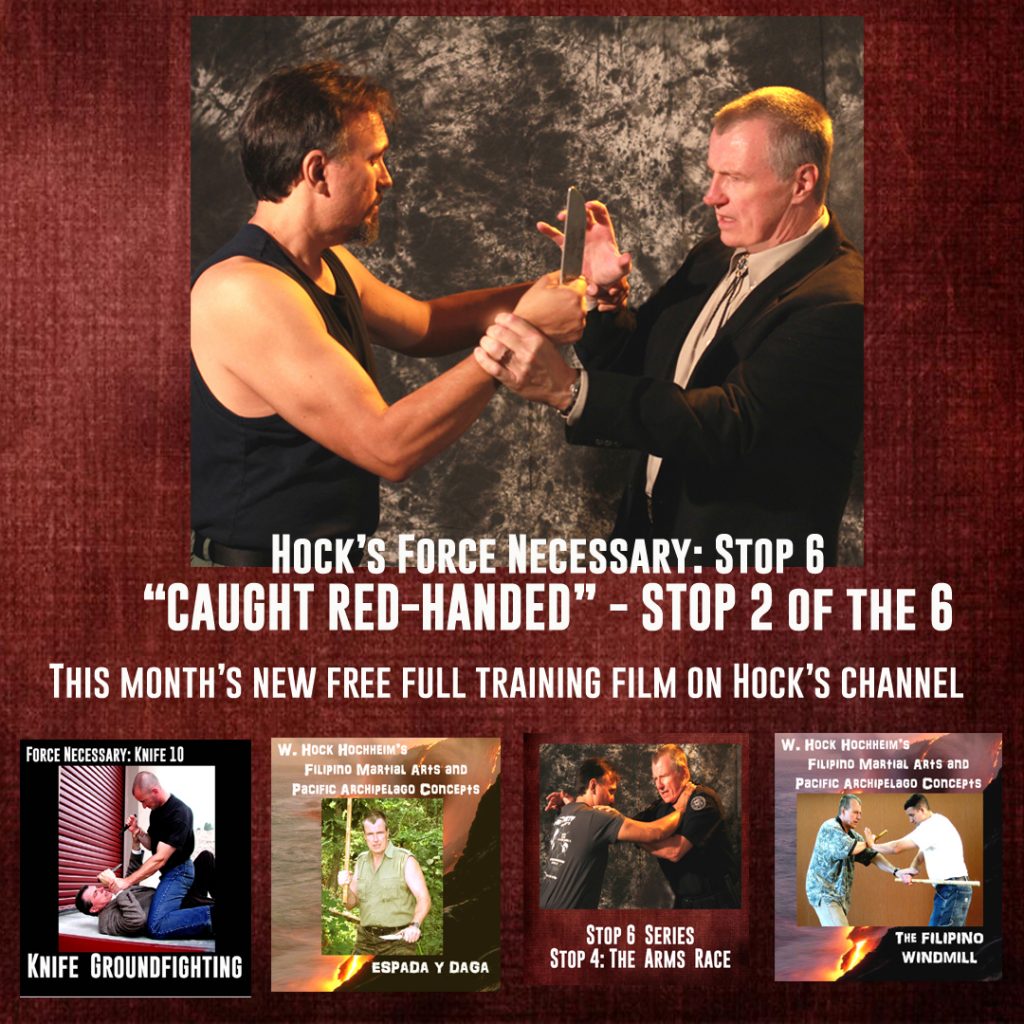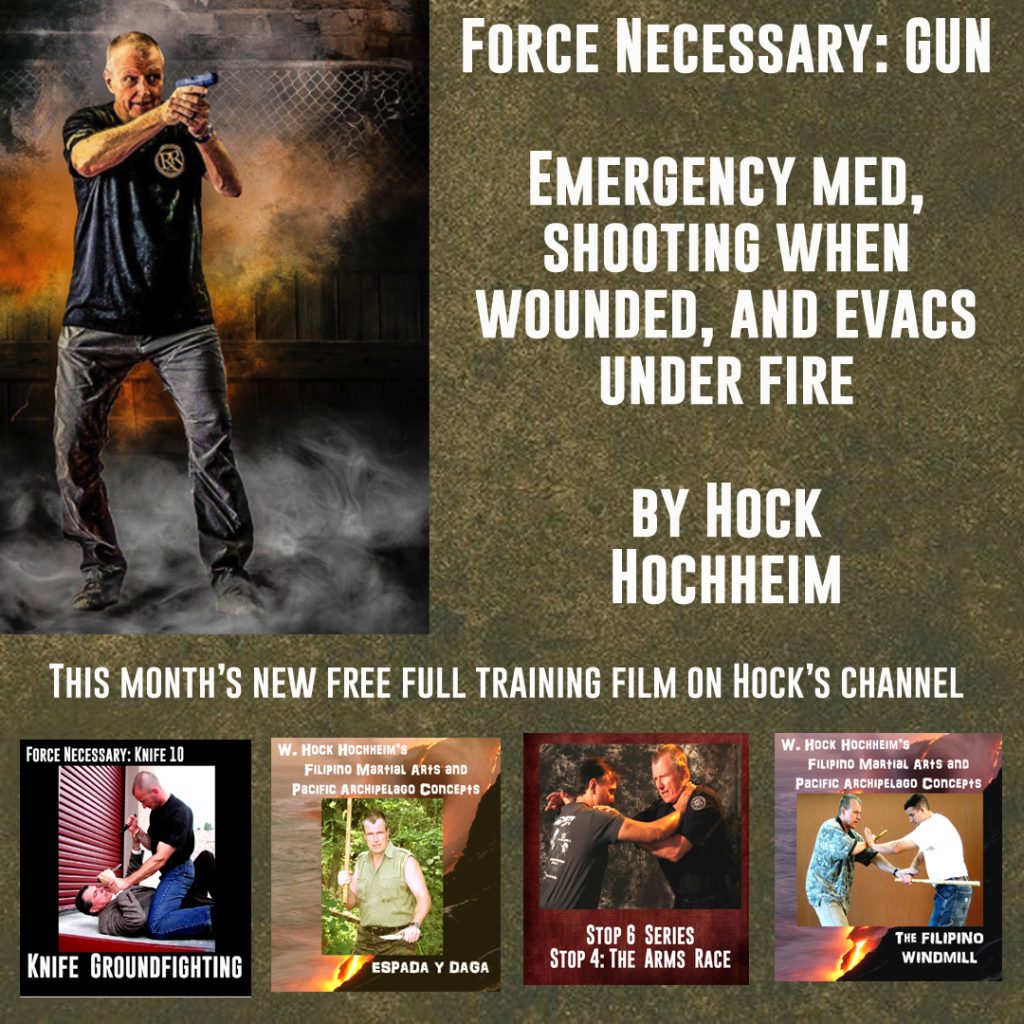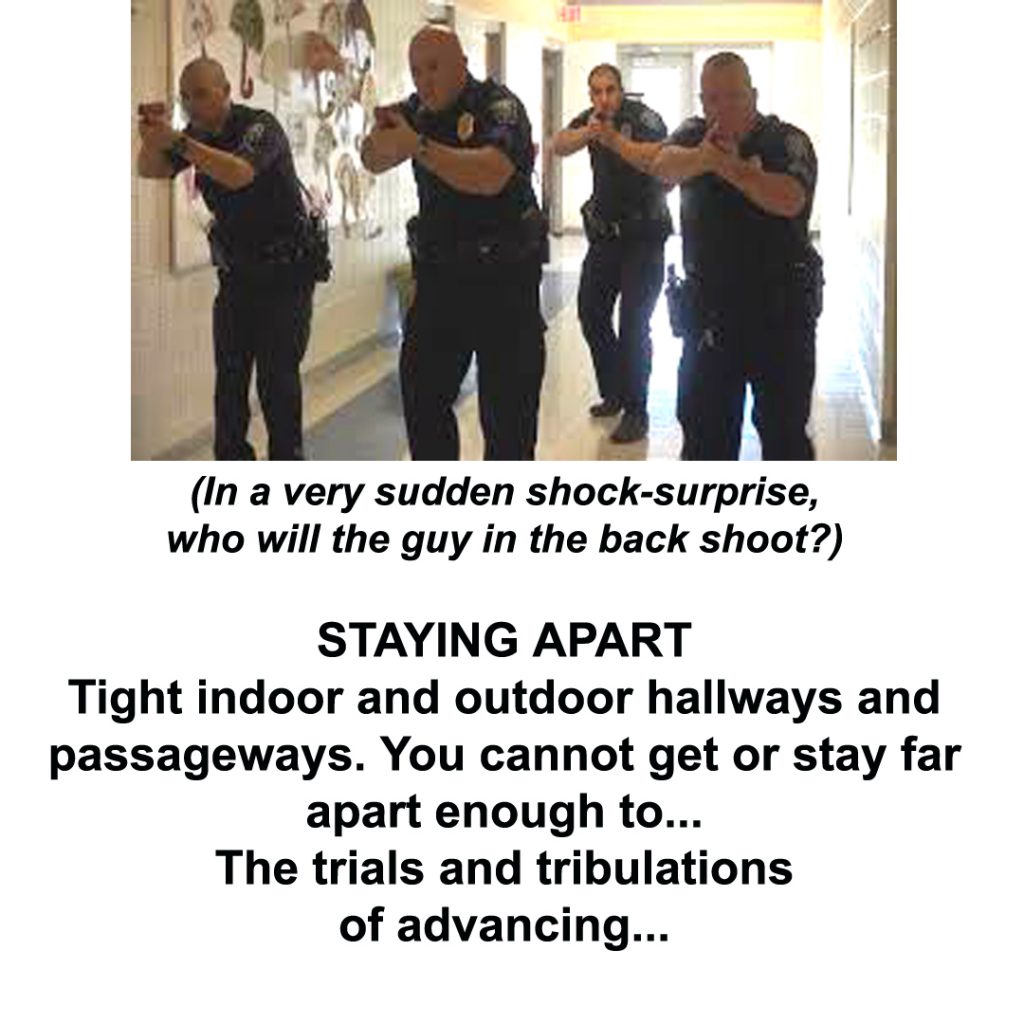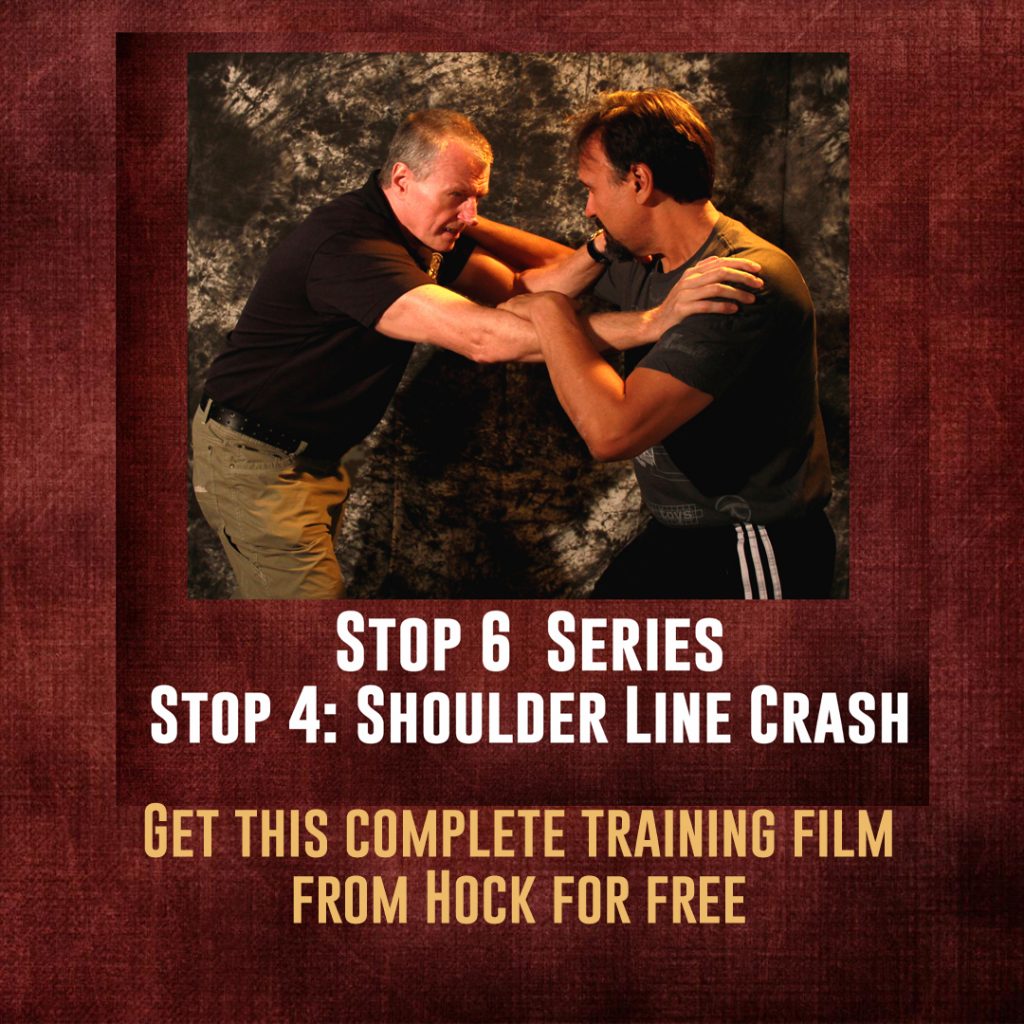
- Question: How do I Become a Scientific Fighting Congress (SFC) instructor? Or obtain rank? How Does This Training Work?
The SFC is the corporate name of all this. The year 2025 is the 30th year of our international operation. We have thousands of members in many countries as far as China and Australia. Under that corporate SFC umbrella are the 7 big programs or courses. First pick a course or courses.
- Force Necessary: Hand! The unarmed course
- Force Necessary: Stick! The impact weapons course
- Force Necessary: Knife! The knife course
- Force Necessary: Gun! The gun course
- Close Quarter Concepts Group: Completion of the above hand, stick, knife, gun. For example, if someone is FN: Hand 3, FN Stick 3, FN Knife 3, FN: Gun 3, they are automatically in the CQC Group 3.
- Defender!: The Police Judo, enforcement-security course
- Essential Filipino Martial Arts (FMA) and Pacific Archipelago Concepts (PAC): Materials from Indonesia, Hawaii, Japan, Philippines. A ranker gets two certifications for “the price of the one” in FMA and PAC.
- Note- Due to my long engagement with Kajukenbo and an 8th Dan ranking, I am capable of shepherding FN: Hand practitioners into this fantastic martial art. Contact me for details.
- Note- These levels are not long, not complicated and built to be an easily digested progression. Technically everything should be in level 1 simple! But it can’t be squeezed into Level 1. It has to be spaced out for this digestion. Various rankings in each or all the courses can be achieved in seminars and classes. Train with us and master these levels. Instructorships are available in each course. Instructorships involve classroom training, hands-on practice and both written and physical testing in a designated camp or course.
- The teaching levels are:
- Class Organizer authorized to develop your skills with partners for advancement.
- Basic Instructor upon completing any 3 levels in a course.
- Advanced Instructor upon completing any 6 levels in a course.
- Specialist Instructor upon completing any 9 levels in a course.
- “Black Belt” Instructor upon completing Level 10. We know that in the business of teaching, one important credential among others, among the students of the world, is the accomplishment of a Black Belt. And with that? Your training/understanding truly begins. This is an old black belt adage that is and should be very true.
- Finish any three levels in one course (they need not be order) and then qualify as a basic instructor. Finish any 6? Advanced. Finish any 9? Subject Matter Specialist.
- Much of the early testing is done at seminars as I will teach that level’s material and watch a candidate perform it in amongst other students.
My typical seminars are about 12 to 14 hours over a weekend. I only plan on teaching certain themes for about 6 to 8 of these hours. The other hours I select material needed by the attendees. Some camps are geared specifically for rank advancement and those are the best places to go to for advancement. Most seminars are just about various subject matters. Also, of course, your regional instructor, or your favorite non-regional instructor can promote you too, in his or her regular classes, semi-privates or privates.
Question: Must Instructors Teach Only Force Necessary Material?
NO! Of course not. You are free to do as you wish. Some SFC instructors..
- Exclusively teach SFC material, or…
- Run SFC courses in their school or other schools, and-or…
- Mix SFC material into their existing program, and-or…
- Lease time in schools, gyms, rec. centers, etc..
- Use their backyards and garages to teach.
- Travel on their own seminar circuit.
- Are also instructors of other very famous courses! And teach those too.
- Are military and police instructors and teach those services too.
- I don’t care what you do! It is important to improvise and grow. These programs are about you not me. Your growth, success and education.
Question: Is there expensive, re-certification or instructor re-certification?
No. It’s free and automatic when you simply attend another annual seminar. If you don’t attend, after a while, unless there are common-sense, extenuating circumstances, you sort of drop-drift off the active rolls. I don’t want to bother people with annual fees. You need your own money!
I do need to see ranking practitioners and instructors about once a year when common-sense-possible, because a common seminar will have a new theme, new materials and new evolutions. We never stop processing and progressing material. So, about once a year you need to swing by and see me if you can. I try to get close to you. No doubt I will travel more than my share to get within striking distance of you.
Re-certification? We need to see rank holders and instructors about once every year. Or some reason why we can’t. (I am very flexible.) People listed on our instructor pages on our website, are active certified instructors. There are people not on the list that have attained various ranks to include Black Belt levels ranks in the last 30 years, but for whatever private or professional reasons, they are not recently active within this organization. They take up golf!? Have kids? Etc. They still possess these rankings, they are just not listed here on the active-duty pages. We are constantly improving and honing the material, as well as checking on the instructors and their progress. If he doesn’t see them for a long period? They simply fall off the active-duty list. Want back on the active list? Just Attend a seminar.
Question: Can instructors promote their people? Yes.
- An instructor can make/promote one rank level under them.
- Basic instructor can only promote their students to levels 1 and 2, No instructorships.
- Advanced instructor can only make a basic instructor and up to level 5
- Expert instructor can make basic and advanced and up to level 8
- A level 10, a so-called “master” (as in range master not martial arts masters) can promote up to 9
- Each level above makes a level under them. In a way, work in the individual courses help build the time and grade for the CQC Group. An instructor earns the right to purchase rank certificates at a discounted, “wholesale” rate and charge “retail.” Ask me for that information sheet. Ask at Hock@hockscqc.com
- As far as the CQC Group…Only I can make a Hand, Stick, Knife, Gun Close Quarter Combat Group rank or instructors, as each individual CQC Group level is like its own “black belt test.” This is real slow going and only a few folks, maybe less than 95 hold (now in 30 years of travel), CQC Group rank, yet I teach over 1,000 people a year, sometimes more.
Question: How do SFC Tests Work?
We have been using the “College Approach.” Simply put? You do not have to take our modules in order. You can complete course levels out of order. I am already scheduling seminars for 2025, my 30th year on the road. In some circumstances, I may only return to a city around the world in a year and a half now, not every year. Worse, complicating the mission, I really am consistently asked for rank progressions and instructorships. Squeezing all this in, IN PROMOTIONAL ORDER for each person, is just about impossible to schedule.
Every single thing I teach is within a course we have. Though there are ten levels in each course, the tenth is a big test, so there are 9 levels of study in each course. That’s nine times four. 36 levels. 36 modules. Granted the modules are short and simple, but they take time to do, to teach and get to. Getting to them all, for everyone gets harder and harder each year. In a perfect world, like the perfect college schedule, you would start with “Subject 101” and proceed in perfect order, on through the “Subject 400s.” Ever done that? Who do you know that has? It is next to impossible.
When folks go to college, they do the best they can, getting the courses they need. But when registering, they take the subjects and classes that are open to them at the time, wrestling with both their schedules and the college-scheduled offerings. This means a college student may actually start in class “Subject 105,” rather than “Subject 101” because the 101 class is full. (I actually took all my college senior level business courses first!. Yes! As a night student no one seemed to care. So I took “401, 402- on up.” Took the others later as I could get them.) So, you can achieve out of order.
Complete any three levels? You can become an instructor. Instructors can teach ANY SFC level material, but only promote people in the levels they tested for. Any six levels? Any nine levels? And so on. Another simple way to put this, if on any given Sunday I teach Knife 6 and you complete it successfully? You can get official credit for Knife 6, even though you haven’t finished knife 5. We’ll all catch up with everything you in the end.
This will facilitate more people to achieve what they deserve this way, given our constricted opportunities.
Some arts and programs have prerequisites. Seen this before? “Must Take Class 301 Before Class 302.” Fortunately, in my practical/tactical course modules, these subjects are not brain surgery or rocket science, nor do they contain difficult katas. They are simply basic, simple things spaced out over time, because not all things can fit in level 1 or “101.” Plus, we expect people will already be working with their local instructors, have the training videos, and also have experience (most folks I see, have experience) in a variety of systems and schools.
So now, simply put? You do not have to take or test for our modules in strict order. You don’t ever have to take a test. You can just train for knowledge. Nice if you would? Best if you would. But like college, you can complete course levels out of order.



 “Interrupting the Quick Draw.” or, sometimes I’ve call “Gun Arm Grappling.” Martial, police and military material I have been working on for decades. When teaching this segment, I must cover as first prep, a review the Stop 6 problems. The gun (pistol and long gun) (also in the stick and knife course.)
“Interrupting the Quick Draw.” or, sometimes I’ve call “Gun Arm Grappling.” Martial, police and military material I have been working on for decades. When teaching this segment, I must cover as first prep, a review the Stop 6 problems. The gun (pistol and long gun) (also in the stick and knife course.)



 bit below and above the elbow.
bit below and above the elbow.  pain and bone chipping injury to the striker (and yes and damage to the receiver). Ever walk through a doorway and nick the tip your elbow? Your elbow tip is nicknamed the “Funny Bone,” but the sharp pain comes from the Ulnar nerve that is near-surface at the hard elbow tip. This hurts in an odd way. Merely cutting the opponent’s face with your elbow tip is a sports assignment to mostly cause bleeding. Such is a “clock move.” A street survivor cannot, should not count on, or watch the clock tick-tock away for debilitating bleeding into the eyes. There’s no time for that. And also there are no refs studying the intensity of medical injuries to call the fight. I believe if you took a survey, Thai fighters would probably be hoping for, working toward smash hits and not little, superficial cuts when striking the head zone. Cutting is an after thought when a full smash failed. (Also, classic boxers will try to “cut” the face with twisting boxing gloves and maybe illegal, sneaky elbows to cause bleeding. Once again in boxing the clock and rounds and refs count for a lot strategy.)
pain and bone chipping injury to the striker (and yes and damage to the receiver). Ever walk through a doorway and nick the tip your elbow? Your elbow tip is nicknamed the “Funny Bone,” but the sharp pain comes from the Ulnar nerve that is near-surface at the hard elbow tip. This hurts in an odd way. Merely cutting the opponent’s face with your elbow tip is a sports assignment to mostly cause bleeding. Such is a “clock move.” A street survivor cannot, should not count on, or watch the clock tick-tock away for debilitating bleeding into the eyes. There’s no time for that. And also there are no refs studying the intensity of medical injuries to call the fight. I believe if you took a survey, Thai fighters would probably be hoping for, working toward smash hits and not little, superficial cuts when striking the head zone. Cutting is an after thought when a full smash failed. (Also, classic boxers will try to “cut” the face with twisting boxing gloves and maybe illegal, sneaky elbows to cause bleeding. Once again in boxing the clock and rounds and refs count for a lot strategy.) Never an elbow tip? In being comprehensive, I would be remiss not to mention this “blocking” move. Some systems suggest stopping-blocking an incoming face punch with an elbow positioned in front of the face. Very Filipino. Standing or on the ground, this involves raising your bent arm up quickly, getting your elbow aimed at an incoming bare fist. Yes, this can damage the incoming fist. Some people have the wrong impression about hitting the incoming fist with one’s elbow in general – they think it’s like hitting a bullet with a bullet. “Chasing the fist.” The supporters say the attacker is punching your face, and your mission is to position your elbow up into the line, the punch’s common path. You are not chasing anything. You are placing not chasing. But, when upright, standing there are a lot of ancillary skills like prediction, athleticism and situations involved with this whereas simple dodging and blocking basics might be way more reflexive, comprehensive and simpler. And actually it’s easier on your back, on the ground. Less…”geography.”
Never an elbow tip? In being comprehensive, I would be remiss not to mention this “blocking” move. Some systems suggest stopping-blocking an incoming face punch with an elbow positioned in front of the face. Very Filipino. Standing or on the ground, this involves raising your bent arm up quickly, getting your elbow aimed at an incoming bare fist. Yes, this can damage the incoming fist. Some people have the wrong impression about hitting the incoming fist with one’s elbow in general – they think it’s like hitting a bullet with a bullet. “Chasing the fist.” The supporters say the attacker is punching your face, and your mission is to position your elbow up into the line, the punch’s common path. You are not chasing anything. You are placing not chasing. But, when upright, standing there are a lot of ancillary skills like prediction, athleticism and situations involved with this whereas simple dodging and blocking basics might be way more reflexive, comprehensive and simpler. And actually it’s easier on your back, on the ground. Less…”geography.”  those who have played American football often innocently go fist-to-fist, or fists-near-fists, striking in what sometimes looks looks like an overly-done torso upper body pivot. This is an unsafe in that it leaves the head exposed. Elbow striking Thai boxers usually put their support arm forearm up and somewhat straight up. Some Thai systems will place the back of their thumb on their the top of their foreheads as a matter of routine, creating a vertical “bar” in front of their face.
those who have played American football often innocently go fist-to-fist, or fists-near-fists, striking in what sometimes looks looks like an overly-done torso upper body pivot. This is an unsafe in that it leaves the head exposed. Elbow striking Thai boxers usually put their support arm forearm up and somewhat straight up. Some Thai systems will place the back of their thumb on their the top of their foreheads as a matter of routine, creating a vertical “bar” in front of their face. Catching-Trapping. Then at times the support hand might be used to capture targets like the head, and even the arms. And the thrusting elbow can be used like a strike for elbow hyperextensions and for shoves inside takedowns.
Catching-Trapping. Then at times the support hand might be used to capture targets like the head, and even the arms. And the thrusting elbow can be used like a strike for elbow hyperextensions and for shoves inside takedowns. 





 He jumped on the fence and starting climbing, and I reached up and grabbed him. He clung like bat on the chain link. I reached around, cussed and slapped his face a few times. Hammer-fisted his hands, loosening his grip. He dropped back into the yard.
He jumped on the fence and starting climbing, and I reached up and grabbed him. He clung like bat on the chain link. I reached around, cussed and slapped his face a few times. Hammer-fisted his hands, loosening his grip. He dropped back into the yard. “Don’t do it, Tonto! They’ll beat the snot out of you!”
“Don’t do it, Tonto! They’ll beat the snot out of you!”



